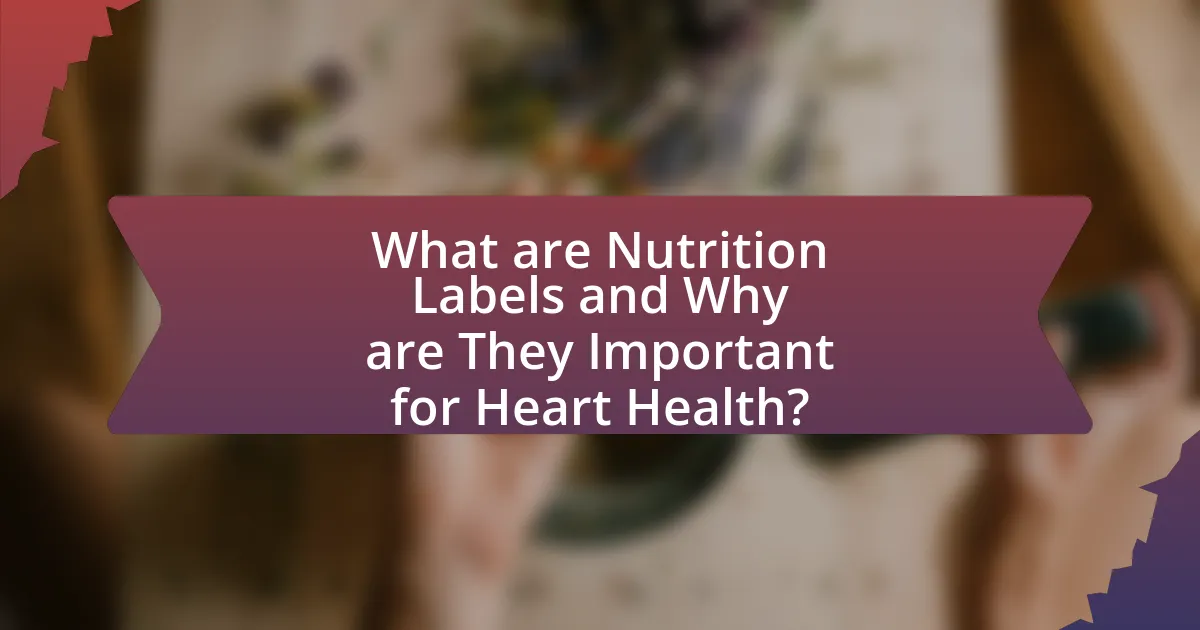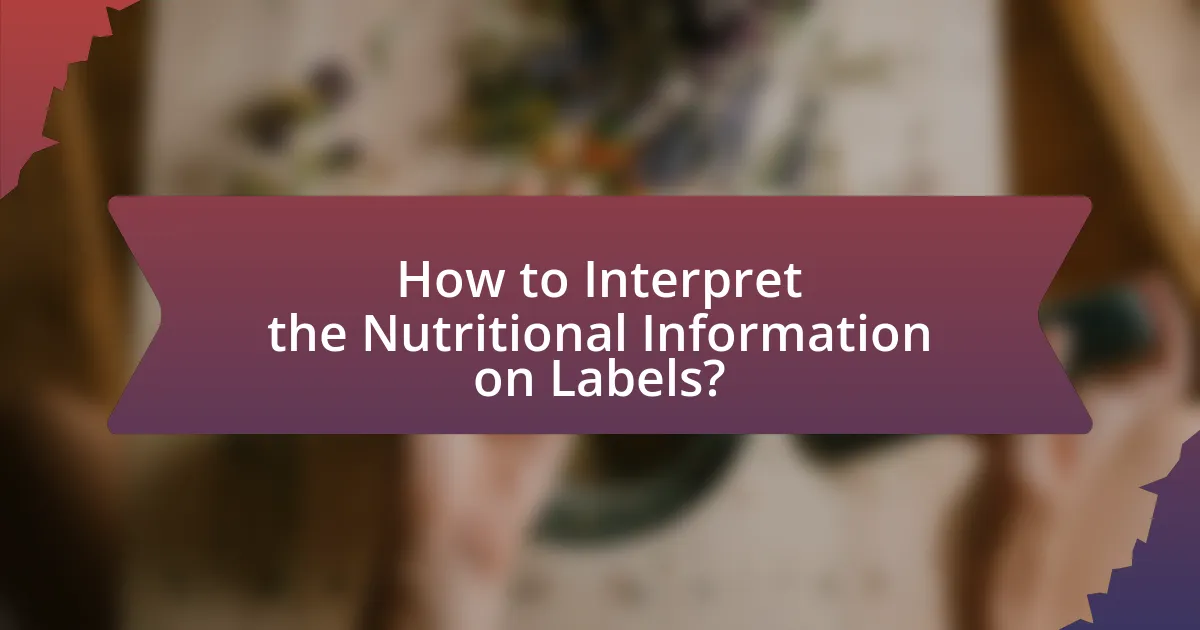Nutrition labels are essential tools found on food packaging that provide critical information about the nutritional content of products, including calories, fats, sugars, and sodium. Understanding these labels is vital for making heart-healthy dietary choices, as they help consumers manage cholesterol levels, blood pressure, and overall cardiovascular risk. The article outlines how to interpret nutrition labels effectively, highlighting key components such as serving size, nutrient amounts, and daily values, while also addressing common mistakes and strategies for selecting heart-healthy foods. By focusing on these aspects, individuals can make informed decisions that align with dietary guidelines for optimal heart health.

What are Nutrition Labels and Why are They Important for Heart Health?
Nutrition labels are detailed guides found on food packaging that provide essential information about the nutritional content of the product, including calories, fats, sugars, and sodium. These labels are crucial for heart health because they enable consumers to make informed dietary choices that can help manage cholesterol levels, blood pressure, and overall cardiovascular risk. For instance, a study published in the Journal of the American College of Cardiology found that individuals who regularly read nutrition labels are more likely to choose heart-healthy foods, which can significantly reduce the risk of heart disease.
How do Nutrition Labels Help in Making Heart-Healthy Choices?
Nutrition labels help in making heart-healthy choices by providing essential information about the nutritional content of food products, enabling consumers to make informed dietary decisions. These labels typically include details on calories, saturated fat, trans fat, cholesterol, sodium, and added sugars, all of which are critical factors in heart health. For instance, the American Heart Association recommends limiting saturated fat to less than 6% of total daily calories and sodium intake to less than 2,300 mg per day. By reading nutrition labels, individuals can identify foods that align with these guidelines, thus reducing their risk of heart disease.
What key information can be found on a Nutrition Label?
A Nutrition Label provides essential information about the nutritional content of a food product. Key information includes serving size, calories per serving, total fat (including saturated and trans fats), cholesterol, sodium, total carbohydrates (including dietary fiber and sugars), and protein. Additionally, it often lists vitamins and minerals, such as Vitamin D, calcium, iron, and potassium. This information helps consumers make informed dietary choices, particularly for maintaining heart health, as it allows them to monitor intake of fats, sodium, and sugars, which are linked to cardiovascular health.
How can understanding Nutrition Labels impact heart health?
Understanding nutrition labels can significantly impact heart health by enabling individuals to make informed dietary choices that reduce the risk of cardiovascular diseases. Nutrition labels provide essential information on the amounts of saturated fats, trans fats, cholesterol, sodium, and added sugars, all of which are linked to heart health. For instance, the American Heart Association recommends limiting saturated fat intake to less than 6% of total daily calories to lower the risk of heart disease. By reading labels, consumers can select products that align with these guidelines, ultimately promoting better heart health through improved dietary habits.
What are the Key Components of Nutrition Labels?
The key components of nutrition labels include serving size, calories, nutrients (such as total fat, saturated fat, trans fat, cholesterol, sodium, total carbohydrates, dietary fiber, sugars, and protein), and vitamins and minerals (like vitamin D, calcium, iron, and potassium). Serving size indicates the amount of food that is typically consumed, while calories provide information on the energy content. Nutrients are listed to inform consumers about the amounts of essential components in the food, which can impact heart health. For example, monitoring sodium intake is crucial for managing blood pressure. The inclusion of vitamins and minerals helps consumers understand the nutritional value of the food, contributing to overall health. These components are standardized by regulatory agencies, ensuring consistency and accuracy across products.
What does the serving size indicate on a Nutrition Label?
The serving size on a Nutrition Label indicates the recommended amount of food or drink that is typically consumed in one sitting. This measurement serves as a reference point for understanding the nutritional information provided, such as calories, fats, and vitamins, allowing consumers to gauge their intake relative to the serving size. For example, if a label states that a serving size is one cup and contains 200 calories, consuming two cups would mean an intake of 400 calories. This standardization helps individuals make informed dietary choices, particularly for heart-healthy eating.
How do calories relate to heart health?
Calories directly impact heart health by influencing body weight and metabolic processes. Excess calorie intake can lead to weight gain, which is a significant risk factor for cardiovascular diseases. Studies indicate that maintaining a balanced caloric intake helps regulate blood pressure and cholesterol levels, both of which are crucial for heart health. For instance, a research study published in the Journal of the American College of Cardiology found that individuals who consumed a diet with controlled calorie intake had a lower incidence of heart disease compared to those with higher caloric consumption. Thus, managing calorie intake is essential for promoting heart health and preventing related diseases.
What are the different types of fats listed on Nutrition Labels?
Nutrition labels typically list three main types of fats: total fat, saturated fat, and trans fat. Total fat represents the overall fat content in the food item, while saturated fat indicates the amount of fat that is solid at room temperature and can raise cholesterol levels. Trans fat, often found in processed foods, is associated with an increased risk of heart disease. These distinctions help consumers make informed choices about their dietary fat intake, which is crucial for maintaining heart health.

How to Interpret the Nutritional Information on Labels?
To interpret the nutritional information on labels, focus on key components such as serving size, calories, and nutrient amounts. The serving size indicates the quantity of food that the nutritional information is based on, which is crucial for understanding how much you are consuming. Calories provide insight into the energy content of the food, helping you manage your daily intake. Nutrient amounts, including fats, carbohydrates, proteins, vitamins, and minerals, inform you about the health benefits or risks associated with the food. For example, a label may indicate the percentage of daily value for nutrients, allowing you to assess how a food fits into your overall diet. Understanding these elements enables informed choices that support heart health, as recommended by dietary guidelines.
What do the percentages of Daily Values mean?
The percentages of Daily Values indicate how much a nutrient in a serving of food contributes to a daily diet based on a 2,000-calorie daily intake. This percentage helps consumers understand the nutritional content of food items in relation to their daily nutritional needs. For example, if a food item contains 20% of the Daily Value for calcium, it means that one serving provides 20% of the calcium that an average adult should consume in a day. This system is designed to assist individuals in making informed dietary choices, particularly for maintaining heart health by monitoring nutrient intake.
How can Daily Values guide heart-healthy eating?
Daily Values (DVs) on nutrition labels guide heart-healthy eating by providing recommended daily intake levels for key nutrients, helping consumers make informed dietary choices. For instance, the American Heart Association recommends limiting saturated fat to less than 10% of total daily calories, which can be easily monitored using the DV percentages on food labels. By comparing the DVs for saturated fat, sodium, and cholesterol, individuals can select foods that align with heart-healthy guidelines, thereby reducing the risk of heart disease.
What should you look for in terms of sodium content?
When evaluating sodium content, aim for products with less than 140 milligrams of sodium per serving, as this level is considered low and beneficial for heart health. High sodium intake is linked to increased blood pressure and cardiovascular disease, making it crucial to monitor sodium levels in food. The American Heart Association recommends limiting sodium intake to no more than 2,300 milligrams per day, ideally reducing it to 1,500 milligrams for optimal heart health.
How can you identify heart-healthy ingredients on Nutrition Labels?
To identify heart-healthy ingredients on Nutrition Labels, look for low levels of saturated fat, trans fat, and sodium, while seeking high amounts of fiber, whole grains, and healthy fats such as monounsaturated and polyunsaturated fats. Heart-healthy foods typically contain less than 5% of the Daily Value for saturated fat and trans fat, and less than 140 mg of sodium per serving. Additionally, ingredients like oats, nuts, seeds, and fatty fish are beneficial for heart health, as they provide essential nutrients and promote cardiovascular wellness.
What are the signs of unhealthy additives or preservatives?
Signs of unhealthy additives or preservatives include long ingredient lists with unrecognizable chemical names, high levels of sodium, added sugars, and artificial colors or flavors. These indicators suggest that the product may contain substances linked to health issues, such as obesity, hypertension, and allergic reactions. For example, the American Heart Association recommends limiting sodium intake to less than 2,300 mg per day, as excessive sodium can lead to cardiovascular problems. Additionally, products with high fructose corn syrup or artificial sweeteners often indicate unhealthy additives that can contribute to metabolic disorders.
How can you spot whole grains and fiber on a label?
To spot whole grains and fiber on a label, look for the term “whole grain” listed as the first ingredient. Whole grains include ingredients like whole wheat, brown rice, and oats. Additionally, check the dietary fiber content in the nutrition facts panel; a product is considered a good source of fiber if it contains at least 3 grams per serving. According to the Whole Grains Council, products labeled with a whole grain stamp indicate that they contain at least 8 grams of whole grains per serving, further confirming their whole grain status.

What Common Mistakes Should You Avoid When Reading Nutrition Labels?
Common mistakes to avoid when reading nutrition labels include overlooking serving sizes, misinterpreting the order of ingredients, and ignoring added sugars. Serving sizes can significantly affect the perceived nutritional value; for example, a product may seem low in calories, but if the serving size is smaller than what you typically consume, the actual intake may be much higher. The order of ingredients indicates the quantity present, so if sugar is listed among the first few ingredients, it suggests a high sugar content. Additionally, many consumers fail to recognize added sugars, which can contribute to heart disease; the American Heart Association recommends limiting added sugars to no more than 6% of daily calories.
How can misleading claims affect your choices?
Misleading claims can significantly distort consumer choices by creating false perceptions about the health benefits of a product. For instance, a product labeled as “low-fat” may still contain high levels of sugar, leading consumers to believe it is healthier than it actually is. Research from the Journal of Consumer Research indicates that consumers often rely on such claims without scrutinizing the nutritional content, which can result in poor dietary decisions. This reliance on misleading information can contribute to health issues, as individuals may choose products that do not align with their heart-healthy goals.
What are some common terms that may confuse consumers?
Common terms that may confuse consumers include “trans fats,” “saturated fats,” “cholesterol,” “sodium,” and “added sugars.” Trans fats are artificial fats that can increase heart disease risk, while saturated fats are typically found in animal products and can also affect heart health. Cholesterol is a waxy substance found in blood, and high levels can lead to heart issues. Sodium, often listed as salt, can contribute to high blood pressure when consumed in excess. Added sugars refer to sugars that are not naturally occurring in foods and can lead to weight gain and other health problems. Understanding these terms is crucial for making informed heart-healthy choices.
How can serving sizes lead to misinterpretation of nutritional content?
Serving sizes can lead to misinterpretation of nutritional content by creating a false perception of the amount of nutrients consumed. When serving sizes are not aligned with actual consumption habits, individuals may underestimate or overestimate their intake of calories, fats, sugars, and other nutrients. For example, a product may list a serving size of 30 grams, but if a person consumes 90 grams, they are actually consuming three times the calories and nutrients indicated on the label. This discrepancy can result in poor dietary choices and health outcomes, as consumers may believe they are adhering to recommended guidelines when they are not. Research indicates that many people do not accurately gauge serving sizes, leading to significant differences in nutritional intake and potential health risks.
What strategies can help you make better choices using Nutrition Labels?
To make better choices using Nutrition Labels, focus on understanding serving sizes, nutrient content, and ingredient lists. First, check the serving size to ensure you are comparing similar portions; for example, a product may seem low in calories, but if the serving size is small, the total calorie intake could be higher than expected. Next, prioritize nutrients that support heart health, such as fiber, healthy fats, and protein, while limiting saturated fats, trans fats, sodium, and added sugars. For instance, the American Heart Association recommends aiming for foods with less than 5% of the Daily Value for saturated fat and sodium per serving. Lastly, examine the ingredient list for whole foods and avoid products with long lists of artificial ingredients or preservatives, as these can indicate lower nutritional quality. By applying these strategies, individuals can make informed choices that align with heart-healthy dietary guidelines.
How can meal planning improve your understanding of Nutrition Labels?
Meal planning enhances your understanding of nutrition labels by requiring you to analyze and compare the nutritional content of various foods before making selections. This process fosters familiarity with serving sizes, calorie counts, and nutrient breakdowns, which are essential for making informed dietary choices. For instance, when planning meals, individuals often review multiple products to identify healthier options, thereby reinforcing their ability to interpret labels accurately. Research indicates that individuals who engage in meal planning are more likely to consume a balanced diet, as they become adept at recognizing key nutritional information, such as sodium and saturated fat levels, which are crucial for heart health.
What tips can help you compare products effectively?
To compare products effectively, focus on key nutritional information such as serving size, calories, and nutrient content. Start by examining the serving size to ensure you are comparing equal amounts; this is crucial as different products may list varying serving sizes. Next, analyze the calorie content to assess energy intake, and prioritize products with lower saturated fats, trans fats, cholesterol, and sodium for heart health. Additionally, look for higher amounts of dietary fiber, vitamins, and minerals, as these contribute to overall health. Research indicates that consumers who pay attention to these factors are more likely to make healthier choices, as evidenced by studies showing that informed label reading can lead to better dietary habits.
What are some practical tips for reading Nutrition Labels for heart-healthy choices?
To make heart-healthy choices, focus on the following practical tips for reading nutrition labels: first, check the serving size to understand the portion you are consuming, as all nutritional information is based on this measurement. Next, look for the total fat content, prioritizing products with lower saturated and trans fats, as these can increase heart disease risk. Additionally, examine the sodium levels, aiming for foods with less than 140 mg per serving to help manage blood pressure. Finally, prioritize products with higher fiber content, as fiber can improve heart health by lowering cholesterol levels. These strategies are supported by dietary guidelines that recommend limiting saturated fat to less than 10% of total daily calories and sodium intake to less than 2,300 mg per day for optimal heart health.





